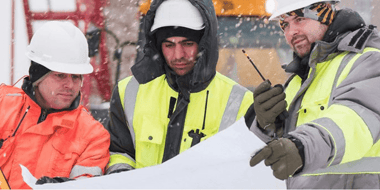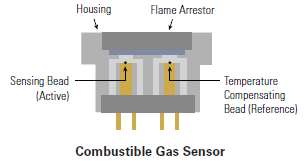"I write this while sitting in a bed in the ER because it's that urgent. We need to get 14 more of the O2 GasBadge Pro monitors… ASAP."
This rush order was a request from an EHS leader at a world-renowned medical center.
The order came on the heels of the FDA-approved COVID-19 vaccine and the distribution of those vaccine doses to health care facilities across the United States. The vaccine, manufactured by Pfizer, must be kept extremely cold at temperatures of minus 70 degrees Celsius and methods for storing and transporting the vaccine come with invisible hazards.
Both processes hinge upon the cold temperatures that are necessary to properly sustain the vaccine doses. Gas detection is a crucial element of ensuring safety in the distribution process.
TRANSPORTING THE COVID-19 VACCINE
Due to the extreme temperature requirements for the vaccine, transportation will likely require some form of dry ice. Dry ice is made by compressing carbon dioxide. As the dry ice “melts,” it gives off CO2, which can create a hazardous environment when it is transported in bulk. The CO2 displaces oxygen, resulting in lower oxygen levels and a more dangerous environment.
“There are definite concerns about carrying the vaccine on an airplane. Any potential for CO2 on a plane means it could get into the cockpit, and that might be a concern,” according to Dave Wagner, director of applications engineering and product knowledge with Industrial Scientific.
For truck shipments, where the supply gets broken down from bulk into smaller deliveries, the issue of leaking CO2 is a minor but still present threat.
“If it’s in a trailer, it’s away from the tractor and the operator isn’t really exposed. When those shipments get broken down – UPS drivers, other people who are carrying it, etc. – the quantity of dry ice they’re carrying is smaller and less likely to result in dangerously low oxygen levels,” said Wagner.
Unfortunately, the CO2 can be difficult to detect without the right equipment. To monitor changing CO2 levels when working with dry ice, the MX6 iBrid® or the Ventis® Pro5 may be the right choice. The MX6 is an adaptable six-gas monitor with hundreds of possible sensor combinations, including oxygen, toxic and combustible gas, and volatile organic compounds.
The Ventis Pro5 Multi-Gas Monitor allows you to monitor CO2 and a number of other gases, while also offering wireless connectivity so you can view real-time gas readings with live monitoring software. With the Ventis Pro5 and live monitoring software, you can see CO2 readings from gas detectors on a cell phone or computer to ensure your team is safe, while actionable alerts on the gas detector can tell users exactly how to respond when a CO2 alarm sounds. This means that even inexperienced gas detector users can quickly and confidently make a safe decision when conditions become dangerous.
STORING THE COVID-19 VACCINE
In terms of storage, warehouses, hospitals or other health centers are likely to store the vaccine in cryogenic rooms or coolers to achieve the ultra-cold temperatures that keep the vaccine stable. These cryogenic cooling methods rely on liquid nitrogen, which require some special precautions.
“Any time you have liquid nitrogen involved, you have to be concerned about leaks, because then you have an immediate hazard,” said Wagner. “A liquid nitrogen leak will deplete the oxygen in the area.”
Similar to CO2, liquid nitrogen also displaces oxygen. Many medical facilities have specific health and safety standards to maintain when using potentially dangerous materials. In some hospitals, for instance, local fire departments and agencies require oxygen monitoring when liquid nitrogen is being used.
In rooms with cryogenic coolers, a nitrogen leak will fill the room and deplete oxygen. Entering a room with a leak, without first knowing whether it’s safe to do so, may result in death. This is why gas monitors are key to worker safety.
While labs and facilities that produce the vaccine are likely to use fixed monitors to maintain health and safety standards, portable gas monitors with oxygen sensors are useful for facilities that might not have a gas detection program in place. The interchangeable sensors enable the device to quickly adapt to situations where it is necessary to monitor unsafe levels of oxygen, for instance, when storing vaccines during a global pandemic.
Low oxygen levels, of course, can be identified with a gas detector equipped with an oxygen sensor. A gas monitor like the GasBadge® Pro can alert workers to hazards, so they stay safe as they deliver this lifesaving vaccine to the public. When you have gas detection equipment you can rely on, you’re free to focus on your duties, knowing that you’re safe.
KEEP BASIC SAFETY IN MIND
With the dangers of COVID-19 so clear, it can be easy to forget about invisible gas hazards. However, it’s important to monitor for low oxygen levels and high carbon dioxide levels when transporting and storing the COVID-19 vaccine. It could mean the difference between a safe situation and a potentially life-threatening one.
Whether it be from a rush request from medical labs, hospitals, or air or ground transport, the vaccines need to move quickly, with the safety of workers in mind. This means not having to worry about hazardous gases creating a potentially dangerous situation, thus delaying a time-sensitive vaccine.
Let Industrial Scientific serve you, so that you can serve others. Contact us today to learn whether you need gas detectors to keep your workers safe. Our rental options allow you to get gas detectors as quickly as tomorrow and keep them for as long as you need.



